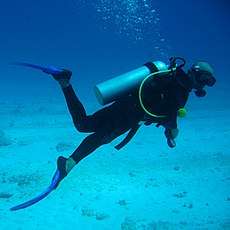Standard diving dress
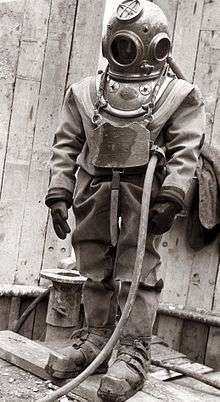 Diver in standard diving dress | |
| Other names | Heavy diving gear |
|---|---|
| Uses | Personal protective equipment with surface supplied breathing air for underwater diving |
| Inventor | Deane brothers and Augustus Siebe |
Standard diving dress (also known as hard-hat or copper hat equipment, or heavy gear) is a type of diving suit that was formerly used for all underwater work that required more than breath-hold duration, which included marine salvage, civil engineering, pearl shell diving and other commercial diving work, and similar naval diving applications. Standard diving dress has largely been superseded by lighter and more comfortable equipment.
Standard diving dress consists of a diving helmet made from copper and brass or bronze, an air hose from a surface supplied diving pump, a waterproofed canvas suit, a diving knife, and weights to counteract buoyancy, generally on the chest, back and shoes.[1] Later models were equipped with a diver's telephone for voice communications with the surface.
Some variants used rebreather systems to extend the use of gas supplies carried by the diver, and were effectively self-contained underwater breathing apparatus, and others were suitable for use with helium based breathing gases for deeper work. Divers could be deployed directly by lowering or raising them using the lifeline, or could be transported on a diving stage. Most diving work using standard dress was done heavy, with the diver sufficiently negatively buoyant to walk on the bottom. Standard diving dress is also sometimes known in the US as a Diver Dan outfit from the television show of the same name.
History
Early history
In 1405, Konrad Kyeser described a diving dress made of a leather jacket and metal helmet with two glass windows. The jacket and helmet were lined by sponge to "retain the air" and a leather pipe was connected to a bag of air.[2]:693 A diving suit design was illustrated in a book by Vegetius in 1511.[2]:554
Borelli designed diving equipment that consisted of a metal helmet, a pipe to "regenerate" air, a leather suit, and a means of controlling the diver's buoyancy.[2]:556 In 1690, Thames Divers, a short-lived London diving company, gave public demonstrations of a Vegetius type shallow water diving dress.[2]:557 Klingert designed a full diving dress in 1797. This design consisted of a large metal helmet and similarly large metal belt connected by leather jacket and trousers.[2]:560
Development of the standard diving dress

The first successful diving helmets were produced by the brothers Charles and John Deane in the 1820s.[3] Inspired by a fire accident he witnessed in a stable in England,[4] he designed and patented a "Smoke Helmet" to be used by firemen in smoke-filled areas in 1823. The apparatus comprised a copper helmet with an attached flexible collar and garment. A long leather hose attached to the rear of the helmet was to be used to supply air – the original concept being that it would be pumped using a double bellows. A short pipe allowed breathed air to escape. The garment was constructed from leather or airtight cloth, secured by straps.[5]
The brothers had insufficient funds to build the equipment themselves, so they sold the patent to their employer, Edward Barnard. It was not until 1827 that the first smoke helmets were built, by German-born British engineer Augustus Siebe. In 1828 they decided to find another application for their device and converted it into a diving helmet. They marketed the helmet with a loosely attached "diving suit" so that a diver could perform salvage work but only in a full vertical position, otherwise water entered the suit.

In 1829 the Deane brothers sailed from Whitstable for trials of their new underwater apparatus, establishing the diving industry in the town. In 1834 Charles used his diving helmet and suit in a successful attempt on the wreck of Royal George at Spithead, during which he recovered 28 of the ship's cannon. In 1836, John Deane recovered timbers, guns, longbows, and other items from the recently rediscovered wreckage of the Mary Rose.
By 1836 the Deane brothers had produced the world's first diving manual, Method of Using Deane's Patent Diving Apparatus which explained in detail the workings of the apparatus and pump, plus safety precautions.
In the 1830s the Deane brothers asked Siebe to apply his skill to improve their underwater helmet design.[6] Expanding on improvements already made by another engineer, George Edwards, Siebe produced his own design; a helmet fitted to a full length watertight canvas diving suit. The real success of the equipment was a valve in the helmet that meant that it could not flood no matter how the diver moved. This resulted in safer and more efficient underwater work.
Siebe introduced various modifications on his diving dress design to accommodate the requirements of the salvage team on the wreck of the HMS Royal George, including making the helmet be detachable from the corselet; his improved design gave rise to the typical standard diving dress which revolutionised underwater civil engineering, underwater salvage, commercial diving and naval diving.[6]
In France in the 1860s, Rouquayrol and Denayrouze developed a single stage demand regulator with a small low pressure reservoir, to make more economical use of surface supplied air pumped by manpower. This was originally used without any form of mask or helmet, but vision was poor, and the "pig-snout" copper mask was developed in 1866 to provide a clearer view through a glass faceplate on a copper mask clamped to the neck opening of the suit. This was soon improved to become a three-bolt helmet supported by a corselet (1867). Later versions were fitted for free-flow air supply.[7]
Later the standard helmet was modified for use with helium mixtures for deep work. This incorporated a carbon dioxide scrubber attached to the back of the helmet, with a venturi powered circulation system to recycle the gas, making it effectively a semi-closed circuit rebreather, much like the Dräger bubikopf helmet rebreather system.[8]
Developments beyond the standard diving dress
More recent diving helmet designs can be classified as free-flow and demand helmets. They are generally made of stainless steel, fiberglass, or other strong and lightweight material. The copper helmets and standard diving dress are still widely used in parts of the world, but have largely been superseded by lighter and more comfortable equipment.
General description


Standard diving dress can be used up to depths of 600 feet (180 m) of sea water, provided a suitable breathing gas mixture is used. Air or other breathing gas may be supplied from hand pumps, compressors, or banks of high pressure storage cylinders, generally through a hose from the surface, though some models are autonomous, with built-in rebreathers. In 1912 the German firm Drägerwerk of Lübeck introduced their own version of standard diving dress using a gas supply from an oxygen rebreather and no surface supply. The system used a copper diving helmet and standard heavy diving suit. The breathing gas was circulated by using an injector system in the loop. This was developed further with the Modell 1915 "Bubikopf" helmet and the DM20 oxygen rebreather system for depths up to 20m, and the DM40 mixed gas rebreather which used an oxygen cylinder and an air cylinder for the gas supply for depths to 40m.[9]
Another unusual variation was the "pig-snout mask" of Rouquayrol-Denayrouze, which used a copper full-face mask clamped to the diving suit, which was structurally similar to the front of a copper helmet, and functioned in much the same way. It tended to sit quite far forward, making it inconvenient except when looking down, but was quite popular among German amber divers, as they spent most of their time looking down at the bottom.[7]
A continuous flow of compressed air is provided to the helmet and vented to the surrounding water at a pressure very close to the ambient pressure at the exhaust port,[1] which lets the diver breathe normally. The helmet must have a non-return valve at the air inlet port of the helmet, to prevent massive and fatal squeeze, should the air line be cut at the surface. Diving helmets, while very heavy, displace a great deal of water and combined with the air in the suit, would make the diver float with his head out of the water.[2]:33 To overcome this, some helmets are weighted on the corselet, while other divers wear weighted belts which have straps that go over the corselet. Some divers have an air inlet control valve, while others may have only one control, the exhaust back-pressure. Helmet divers are subject to the same pressure limitations as other divers, such as decompression sickness and nitrogen narcosis.[2]:1
The full standard diving dress can weigh 190 pounds (86 kg).[10]
Suit
The earliest suits were made of waterproofed canvas invented by Charles Mackintosh. From the late 1800s and throughout most of the 20th century, most suits consisted of a solid sheet of rubber between layers of tan twill. Their thick vulcanized rubber collar is clamped to the corselet making the joint waterproof. The inner collar (bib) was made of the same material as the suit and pulled up inside the corselet and around the diver's neck. The space between the bib and corselet would trap most condensation and minor leakage in the helmet, keeping the diver dry. The sleeves could be fitted with integral gloves or rubber wrist seals and the suit legs ended in integral socks.[11]
The twill was available in heavy, medium, and light grades, with the heavy having the best resistance to abrasion and puncture against rough surfaces like barnacles rocks and the jagged edges of wreckage. Vulnerable areas were reinforced by extra layers of fabric.[11] Different types of dress are defined by the clamping of the collar seal to the rim of the corselet or to the joint between bonnet and corselet, and the number of bolts used for this purpose.[12] The legs may be laced at the back to limit inflated volume, which could prevent excess gas from getting trapped in the legs and dragging an inverted diver to the surface.[2]:56[11] In normal UK commercial diving activities, the legs often did not have the lace up option.
The rubberised fabric was waterproof, as was the seal to the helmet and the cuff seals, so the diver remains dry – a big advantage during long dives – and wears sufficient clothing under the suit to keep warm depending on the water temperature and expected level of exertion.[11] The suit was usually a very baggy fit on the diver, and if over-inflated, would be too bulky to allow the diver to reach the control valves for air supply and exhaust. This contributed to the risk of suit blowup, which could cause an uncontrollable buoyant ascent, with high risk of decompression illness. To add to this problem, a runaway ascent could cause sufficient internal pressure to burst the seal at the corselet, which could result in a loss of buoyancy, and the injured diver sinking back to the bottom in a flooded suit. Consequently, divers would ensure that they remained sufficiently negative when underwater to minimise this risk. The bulkiness of fit, weighted boots and lack of fins made swimming impracticable. At the surface the diver could struggle a short distance using the arms, but underwater would normally walk on the bottom and climb up and down over obstacles, taking care to avoid passing under anything that could foul the air hose.[11]
Helmet
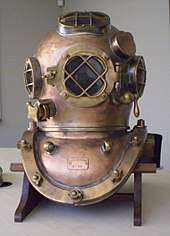
The helmet is usually made of two main parts: the bonnet, which covers the diver's head, and the corselet which supports the weight of the helmet on the diver's shoulders, and is clamped to the suit to create a watertight seal. The bonnet is attached and sealed to the corselet at the neck, either by bolts or an interrupted screw-thread, with some form of locking mechanism.[13]
The helmet may be described by the number of bolts which hold it to the suit or to the corselet, and the number of vision ports, known as lights. For example, a helmet with four vision ports, and twelve studs securing the suit to the corselet, would be known as a "four light, twelve bolt helmet", and a three-bolt helmet used three bolts to secure the bonnet to the corselet, clamping the flange of the neck seal between the two parts of the helmet.[9]
When the telephone was invented, it was applied to the standard diving dress for greatly improved communication with the diver.[12]
Bonnet
The bonnet is usually a spun copper shell with soldered brass or bronze fittings. It covers the diver's head and provides sufficient space to turn the head to look out of the glazed faceplate and other viewports (windows). The front port can usually be opened for ventilation and communication when the diver is on deck, by being screwed out or swung to the side on a hinge. The other lights (another name for the viewports) are generally fixed. Viewports were glass on the early helmets, with some of the later helmets using acrylic, and are usually protected by brass or bronze grilles. The helmet has fittings to connect the air line and the diver's telephone.[12][13]
Later helmets include a non-return valve where the airline is connected, which prevents potentially fatal helmet squeeze if the pressure in the hose is lost. The difference in pressure between the surface and the diver can be so great that if the air line is cut at the surface and there is no non-return valve, the diver would be partly squeezed into the helmet by the external pressure, and injured or possibly killed.[11]
Helmets also have a spring-loaded exhaust valve which allows excess air to leave the helmet. The spring force is adjustable by the diver to prevent the suit from deflating completely or over-inflating and the diver being floated uncontrollably to the surface. The exhaust valve could also be temporarily opened or closed by pressing the internal flange with the chin to let more air out, or by pulling it with the lips to temporarily build up internal volume by closing the valve.[11] Some helmets have an extra manual exhaust valve known as a spit-cock, which was usually a simple quarter-turn valve. This allowed the diver to manually vent excess air when in a position where the main exhaust could not function correctly. Water could also be sucked in through the spitcock and spat onto the viewports to defog them.[11]
Corselet
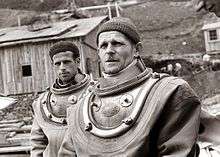
The corselet, also known as a breastplate, is an oval or rectangular collar-piece resting on the shoulders, chest and back, to support the helmet and seal it to the suit, usually made from copper and brass, but occasionally steel.[9] The helmet is usually connected to the suit by placing the holes around the rubberised collar of the suit over bolts along the rim of the corselet, and then clamping the brass straps known as brailes (or brails) against the collar with wing nuts to press the rubber against the metal of the corselet rim to make a water-tight seal.[13] Shim washers were used under the ends of the brailes to spread the load on the rubber evenly. An alternative method was to bolt the bonnet to the corselet over a rubber collar bonded to the top of the suit.[9]
Most six and twelve bolt helmet bonnets are joined to the corselet by 1/8th turn interrupted thread.[13] The helmet neck thread is placed onto the neck of the corselet facing the divers left front, where the threads do not engage, and then rotated forward, engaging the thread and seating on a leather gasket to make a watertight seal. The helmet usually has a safety lock which prevents the bonnet from rotating back and separating underwater. Other styles of connection are also used, with the joint secured by clamps or bolts (usually three, occasionally two).[9] Some helmets were made with the bonnet and corselet in one piece and secured to the suit in other ways.
Diver's weights
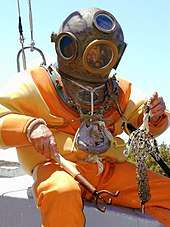
There are two weight systems, both are still in use. The earlier helmet weights are used in pairs. The large horse shoe type weights hold the buoyant helmet down and are suspended from the corselet by figure eight hooks that go over the breast plate weight studs. The Greek sponge divers simply joined the weights with ropes which went over the corselet like saddle bags. The other system is the weight harness, which is a weight belt that fastens around the waist with shoulder straps which cross at the back and go over the breast plate at the shoulders, often with a crotch strap to prevent the harness from riding up when the diver works in tilted positions. The harness system puts the centre of gravity lower, for better upright stability, and prevents excessive weight shift when the diver must work in awkward positions, but still applies the ballast load to the buoyant helmet assembly when upright through the shoulder straps. The US Navy Mk V weight belt was of this style and weighed about 83 pounds (38 kg)[14] but commercial belts were usually about 50 pounds (23 kg).
Weighted shoes
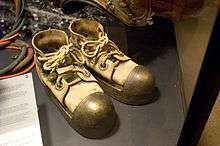
The helmet divers used heavily weighted shoes to steady them on the bottom. The weighted sole is bolted to a wooden insole, which in turn has a leather, canvas or rubber upper. Lead was the most common sole and a pair could weigh 34 pounds (15 kg). Brass soled shoes with canvas uppers were introduced in WWII and are still in use. Some early brass shoes were called sandals because they were a casting held to the diver's feet by simple straps. Japanese divers often used iron soled shoes. The diver tends to lean forward against the drag of the water when walking on the bottom, and could often not see where he was putting his feet, so the toes are capped, usually with brass.
Diver's knife
The diver's knife is a tool which is primarily intended for cutting away entanglement with ropes, lines and nets. It can also be used to some extent to pry and hammer, as well as cut, and may have a metal pommel for hammering, but the professional diver generally carries tools better suited to the work, and will use a hammer or pry-bar when that work is planned. The knife often has one side of the blade serrated to cut heavy material such as thick rope, and a sharper plain edge for cutting fine lines such as monofilament fishing line and nets. There are two common styles of traditional diver's knife sheaths; one is flat with a spring retention and the other has a circular section with an ajax triple start thread, allowing the diver to insert the knife in any orientation, rotate to engage the threads and lock the knife into the sheath.[15][16]
Air supply
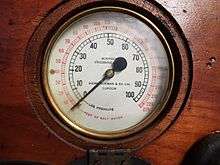
Originally supplied with air by a manually operated diver's air pump. Later also supplied by mechanised compressors, but the manual pump remained an option well into the 20th century. Air was supplied through a hose, and a rope strength member added to support the weight of the diver. Later a telephone cable was added and the diver's umbilical was the result of combining these items. Air supply passes through a non-return valve at the connection to the helmet, which prevents back flow if the hose is cut.[11]
Flow of air through the helmet could be controlled by manually adjusting the back-pressure on the helmet exhaust valve, usually on the lower right side of the bonnet, and by manually adjusting the inlet supply valve on the airline, usually fastened to the front lower left of the corselet.[11] Flow rate would also be affected by the surface delivery system and depth. Manual pumps would be operated at the speed necessary for sufficient air supply, which could be judged by delivery pressure and feedback from the diver. Many manual pumps had delivery pressure gauges calibrated in units of water depth - feet or metres of water column - which would provide the supervisor with a reasonable indication of diver depth.
Diver's air pump
Manual systems
Air supply hose
- Airline: The earliest air hoses were made from leather, but by 1859 rubber was in use.[21] rubber was later used as a coating on a strength layer of woven fabric. This could be built up in layers to achieve the required strength to withstand the necessary internal pressure, which was proportional to the depth at which the diver worked.
- Umbilical: A diver's umbilical is a cable made up of all the required services to the diver. When used for later versions of standard diving dress this included the air hose, and usually also included a diver telephone cable, which could include a strength member capable of lifting the diver, and sometimes an electric power supply for one or more lights carried by the diver.
Air control valve
Most later suits had a screw-down air control valve on the air hose to control air flow rate into the helmet.[13] The early helmets did not have air control valves and the diver signaled the surface with pulls on his rope or air line, indicating that he needed more or less air, and the pump operators would change the rate of pumping to suit.
Communications
- Line signals
- speaking tube system (Rouquayrol's patent)
- Diver telephone system
Variations
Two basic systems of attaching the helmet to the suit were in common use: In one style the perimeter of the corselet was clamped to a rubber gasket by up to 12 bolts, using brass brails to distribute the load and provide a reasonably even clamping pressure to make the watertight seal. In this style the bonnet to corselet seal was independent of the seal to the suit, and often used an interrupted thread system, which involved about a 45 degree rotation to engage the thread fully. The other type used a rubber flange which fitted over the neck hole of the corselet, and over which the bonnet was clamped, usually with two or three bolts.[9][13] It was also fairly common to clamp the suit to the corselet edge by brails, and connect the helmet to the corselet by two three or four bolts, which could either be studs tapped into the corselet flange,[22] or fold-away bolts hinged to the corselet, and engaged with slots in the helmet flange.[23]
Three-bolt equipment
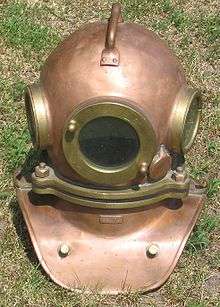
Three bolt equipment, (Tryokhboltovoye snaryazheniye, Russian:Трехболтовое снаряжение, Russian:трехболтовка) consists of an air-hose supplied copper helmet that is fastened to a corselet and waterproof suit by three bolts which clamp the rubber neck flange of the suit between the metal flanges of the bonnet and the corselet, making a watertight seal between the helmet and suit.[9], two 16 kilograms (35 lb) lead weights attached to the chest and back, heavy boots made of copper and lead, and a diver's knife.
Three bolt equipment was used by the Russian Navy in the 19th and 20th centuries.
Three-bolt equipment was also made in France by Denayrouze-Rouquayrol from 1874 or earlier,[12] and in Germany by Draegerwerk from about 1912.[9]
Twelve bolt equipment

In twelve bolt equipment the rim of the corselet is clamped to the gasket of the suit, using brass brails to spread the load evenly.[13]
Twelve bolt equipment was manufactured in the UK by Siebe-Gorman and Heinke, in France by Rouquayrol-Denayrouze, and in the US by several manufacturers for the US Navy.[12][9][13]
US Navy Mk V equipment
The US Navy Mk V diving equipment was a standard military specification manufactured by several suppliers, including DESCO, Morse Diving, Miller–Dunn and A. Schräder's Son, over a fairly long period. The major components were: Spun copper and tobin bronze, 12 bolt, 4 light, 1/8 turn neck connection helmet with breastplate (corselet), clamps (brails) and wingnuts, weight 55 pounds (25 kg). Weight harness of lead weights on leather belt with adjustable shoulder straps and crotch strap, 84 pounds (38 kg). Lead soled boots with brass toe caps, canvas uppers with laces and leather straps weighing 17.5 pounds (7.9 kg) each.[14] Suit weight 18.5 pounds (8.4 kg), for a total weight of approximately 190 pounds (86 kg).[10] The Mk V equipment uses a 1/2" air hose with an external 1 1/16" x 17 submarine thread connection on the non-return valve. [24]
Shallow water helmets
Shallow water helmets are not standard diving dress, but were used by divers for shallow work where a dry suit was not required. Generally a shallow water helmet was a single item, which was lowered over the diver's head and rested on the shoulders, with an open bottom, so no exhaust valve was required. The helmet retained an air space as long as it was kept reasonably upright, and if the air spilled out it would refill as soon as the diver returned to an upright posture. The precursor to the standard helmet, Deane's helmet, was of this type.[25]
Gas recirculation
- Draeger injection system.[9]
Demand systems
- Rouquayrol's demand regulator.[7]
Mixed gas systems
- Helium helmets
Accessories
A few accessories were produced that are specific to Standard diving dress, though similar items are available for other diving systems.
Welding visors were made that clamp over the front viewport of the copper helmet. These would have to be made for a specific model helmet as the details of size and shape could vary considerably.[26]
Oil resistant suits were produced once oil-resistant synthetic rubbers became available to coat the exterior of the suit.[27]
Wrist mount diving compasses and watches, and diving lights, are not restricted to use with standard diving equipment, but were produced for use by divers wearing the equipment before other diving equipment became generally available.[28] Underwater lights included hand held torches with a directed beam, and lantern styles, with all-round illumination, and lamps designed to be mounted off the diver to illuminate the work site.[29]
T-spanners (wrenches) and straight spanners for tightening and loosening the wingnuts of the helmet were available from the helmet manufacturers to suit the pattern of wingnut used by the manufacturer.[28]
Cuff expanders were available to allow the diver's attendants to assist the diver to get his hands out of the rubber cuff seals.[30]
Diver telephone systems were commonly used.[31]
Air control panels were required when power driven compressors were used. These varied in complexity, and were available for one or two divers.[32]
Diving procedures
- Water entry and exit was usually either by a substantial ladder or by lowering the diver into the water and lifting him out on a small platform with handholds known as a diving stage.[11] In earlier days less ergonomically desirable methods have been used, like rope ladders.[21]
- Descent: The usual method of descent was for the diver to descend on a shotline. The diver would establish negative buoyancy while holding the line at the surface, then slide down the line, braking as required by holding on with his hands, and with descent speed limited by the tender, who would pay out the umbilical at an appropriate speed.[11]
- Depth monitoring could be done by monitoring the pressure of the supply air at the pump or panel, which would be slightly greater than the depth pressure at the helmet exhaust valve.[11]
- Buoyancy control. The diver controlled buoyancy by adjusting the back pressure of the exhaust valve. The helmet and suit air space were continuous, so air would fill the suit until the deeper parts of the suit exerted sufficient additional pressure to cause the exhaust valve to open. Air volume in the suit would be strongly influenced by posture. Head-up vertical posture was the normal position, and any change from this would require some adjustment of back-pressure to prevent excessive air volume in the suit, which in extreme cases could prevent the diver from reaching control valves, and could lead to a runaway buoyant ascent.[11]
- Flushing and flow rate control. Flow rate of the air supply was adjusted to provide sufficient air for the diver depending on work rate. When air was provided by manual cranking of the pump, it was not desirable to overdo the air supply, as this was unnecessary work for the pump crew. If the diver started building up carbon dioxide by working harder than the air supply could compensate, he could either rest for a while, ask for increased flow rate, control the flow rate at the supply valve, or a combination of these options.[11]
- Demisting the viewports: Some helmets directed inlet air flow over the inside face of the viewports, which was reasonably effective, but if this was not sufficient, the diver could open the spitcock and suck seawater into his mouth, then spit it onto the inside of a fogged viewport. This would wash off the condensation droplets, and the saliva may have helped defogging, as it is known to be effective as a surfactant for this purpose.[11]
- Ascent[11]
- Decompression[11]
- Emergency recompression[33]
Specific hazards
- Helmet squeeze
- Suit blowup
- Gas supply failure
Manufacturers
- Brazil:
- Person, of Sao Paulo.[34]
- Canada:
- John Date, of Montreal.[35]
- Denmark: There was a particular style of corselet rim sealing clamp used in Danish service patented by Peter Hansen Hessing and built under license by various manufacturers, which used only two clamping bolts. [36]
- East Germany:
- Medi. 3-bolt helmets [37]
- France:
- Rouquayrol-Denayrouze, later Specialites Mecaniques Reunis, then Societe Charles Petit, eventually Rene Piel (several name changes) manufactured both 3-bolt and 12-bolt helmets, and both demand and free-flow air supply systems.[12] Trademarks include Rene Piel of Paris,[38] C H Petit, of Paris.[39]
- Scauda, of Mareilles. [40]
- Germany:
- Draeger & Gerling, Lubeck, Established 1889. In 1902 name changed to Draegerwerk, Heinr. & Bernh. Dräger. Draegerwerk produced both rebreather and free-flow helmets.[9][41]
- Franz Clouth of Cöln Nippes.
- Friedrich Flohr, Kiel. Established 1890. Manufactured apparatus of Denayrouze type with three-bolt helmets and regulator backpacks. Later also produced free-flow helmets.[42][37]
- Holland:
- Bikkers of Rotterdam[43]
- Italy:
- Japan:
- Korea:
- Pusan.[50]
- Russia: 3-bolt, 6-bolt and 12-bolt/3-bolt helmets, including helium helmets.[51]
- Spain:
- Sweden: Some of the Swedish helmets were of the "inverted pot" form, with a substantially cylindrical bonnet with a rounded top.[53]
- United Kingdom: Leading British manufacturers were Siebe Gorman and Heinke. Siebe Gorman manufactured a wide range of models over several years, including 12-bolt oval and square corselets, 6-bolt oval corselets.[58] 3 or 4 lights, usually with screw in front window, with tinned or copper finish and round or oval side windows. Over their production period they used at least two styles of wingnut, and a rebreather model.[59] Occasionally more unusual options were chosen, such as 8 bolt corselets.[60] No-bolt model used similar rubber flange to 3-bolt helmets, but clamped between the bonnet and corselet which were connected at the back by a hinge and the helmet swung forward over the head to close, and locked by a clamp in front with a locking device to prevent inadvertent opening.[61]
- In the United States, the dominant makers were DESCO, Morse Diving, Miller–Dunn and Schräder. Among others, Morse Diving Equipment of Boston produced the Mark V Helium MOD 1 rebreather helmet.[62] Some Morse helmets had the air intake on the back of the corselet,[63]
See also
References
- 1 2 Stillson, GD (1915). "Report in Deep Diving Tests". US Bureau of Construction and Repair, Navy Department. Technical Report. Retrieved 2008-08-08.
- 1 2 3 4 5 6 7 8 Davis, RH (1955). Deep Diving and Submarine Operations (6th ed.). Tolworth, Surbiton, Surrey: Siebe Gorman & Company Ltd.
- ↑ Bevan, John (27 May 1996). The Infernal Diver. Submex Ltd. ISBN 0-9508242-1-6.
- ↑ "Archived copy". Archived from the original on 2013-10-27. Retrieved 2013-12-18. Scuba Ed's – History of scuba diving
- ↑ Newton, William; Partington, Charles Frederick (1825). "Charles Anthony Deane – 1823 patent". Newton's London Journal of Arts and Sciences. W. Newton. 9: 341. Archived from the original on 2017-02-16.
- 1 2 Acott, C. (1999). "JS Haldane, JBS Haldane, L Hill, and A Siebe: A brief resume of their lives". South Pacific Underwater Medicine Society Journal. 29 (3). ISSN 0813-1988. OCLC 16986801. Archived from the original on 2011-07-27. Retrieved 2008-07-13.
- 1 2 3 Dekker, David L. "1860. Benoit Rouquayrol – Auguste Denayrouze: Part 1". www.divinghelmet.nl. Archived from the original on 20 September 2016. Retrieved 18 September 2016.
- ↑ Staff. "DESCO 29019 U.S. Navy Helium Diving Helmet w/Double Exhaust Valve (late version)". Commercial Dive Gear » Diving Helmets. Milwaukee, Wisconsin: DESCO. Archived from the original on 7 February 2017. Retrieved 6 February 2017.
- 1 2 3 4 5 6 7 8 9 10 11 Dekker, David L. "1889. Draegerwerk Lübeck". Chronology of Diving in Holland. www.divinghelmet.nl. Archived from the original on 20 September 2016. Retrieved 17 September 2016.
- 1 2 "Deep Sea Diving Suit: The Diving Dress 1943 US Navy Training Film" on YouTube
- 1 2 3 4 5 6 7 8 9 10 11 12 13 14 15 16 17 18 "U.S. Navy Standard Deep Sea Diving Outfit training film 43424 NA" on YouTube
- 1 2 3 4 5 6 Dekker, David L. "1860. Benoit Rouquayrol – Auguste Denayrouze: Part 2". www.divinghelmet.nl. Archived from the original on 10 March 2016. Retrieved 18 September 2016.
- 1 2 3 4 5 6 7 8 "Deep Sea Diving: Assembling the Deep Sea Outfit – 1963 – US Navy Training" on YouTube
- 1 2 "Mark V". Diver's Institute of Technology. Seattle, Washington.
- ↑ Staff. "Commercial Dive Gear » Diver Accessories: U.S. Navy Divers Knife". www.divedesco.com. Retrieved 3 December 2017.
- ↑ Pardoe 2016, pp. 208–222.
- ↑ Pardoe 2016, pp. 176, 181–185.
- ↑ Double action cylinder delivers on both the up and down-strokes
- ↑ Pardoe 2016, pp. 155–176.
- ↑ Pardoe 2016, p. 186.
- 1 2 Marx, Robert F. (1990). The History of Underwater Exploration. Dover books on earth sciences. Courier Corporation,. p. 59. ISBN 9780486264875.
- ↑ Pardoe 2016, pp. 93–98.
- ↑ Pardoe 2016, pp. 99–104.
- ↑ "Diving Equipment Product Specifications DESCO Diving Helmets Hose Connections". Retrieved 7 December 2017.
- ↑ Pardoe 2016, p. 20.
- ↑ Pardoe 2016, p. 237.
- ↑ Pardoe 2016, p.233.
- 1 2 Pardoe 2016, pp. 244–245.
- ↑ Pardoe 2016, pp. 194-207.
- ↑ Pardoe 2016, p. 224.
- ↑ Pardoe 2016, pp. 190–194.
- ↑ Pardoe 2016, pp. 188–189.
- ↑ Bailey, John (2001). The White Divers of Broome: The True Story of a Fatal Experiment (reprint ed.). Pan Macmillan. ISBN 9780732910785.
- ↑ Pardoe 2016, p. 132.
- ↑ Pardoe 2016, p. 138.
- ↑ Pardoe 2016, pp. 110–113.
- 1 2 Pardoe 2016, p. 97.
- ↑ Pardoe 2016, p. 126.
- ↑ Pardoe 2016, p. 127.
- ↑ Pardoe 2016, p. 129.
- ↑ Pardoe 2016, pp. 88–91.
- ↑ Dekker, David L. "1890 Friedrich Flohr, Kiel". www.divinghelmet.nl. Archived from the original on 10 March 2016. Retrieved 18 September 2016.
- ↑ Dekker, David L. "1841. Bikkers Rotterdam". www.divinghelmet.nl. Archived from the original on 24 October 2015. Retrieved 18 September 2016.
- ↑ Pardoe 2016, p. 121–123.
- ↑ Pardoe 2016, p. 125.
- ↑ Pardoe 2016, p. 124.
- ↑ "Introduction". www.divingheritage.com. 2 June 2014. Retrieved 7 December 2017.
- ↑ Pardoe 2016, p. 137.
- ↑ Pardoe 2016, p. 134.
- ↑ Pardoe 2016, p. 131.
- ↑ Pardoe 2016, pp. 114–120.
- ↑ Pardoe 2016, p. 133.
- ↑ Pardoe 2016, pp. 99–102.
- ↑ Pardoe 2016, p. 104.
- ↑ Pardoe 2016, p. 102.
- ↑ Pardoe 2016, p. 99.
- ↑ Pardoe 2016, p. 105.
- ↑ Pardoe 2016, pp. 25–44.
- ↑ Pardoe 2016, p. 50.
- ↑ Pardoe 2016, p. 45.
- ↑ "Siebe Gorman no bolt helmets". www.divingheritage.com. 14 December 2012. Retrieved 7 December 2017.
- ↑ Pardoe 2016, p. 85.
- ↑ Pardoe 2016, p. 81.
Sources
Staff (2016). The Anthony and Yvonne Pardoe Collection of Diving Helmets and Equipment – illustrated catalogue (PDF). Exeter, UK: Bearnes Hampton & Littlewood.
External links
| Wikimedia Commons has media related to Standard diving dress. |
- The Historical Diving Society
- US Naval Undersea Museum
- Diving Heritage
- "Iron Men Under The Sea", January 1931, Popular Mechanics detailed article on salvage divers and diving school in Bremen, Germany
- "Undersea Acrobatics The World Never Sees", December 1931, Popular Mechanics training given divers to go against current on ocean floor pages 974/975
- History of Diving Museum
%2C_is_fitted_with_a_Kirby_Morgan_37_Dive_Helmet.jpg)
